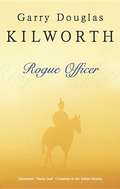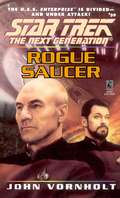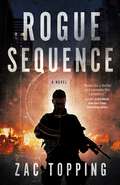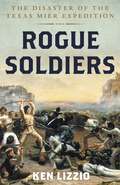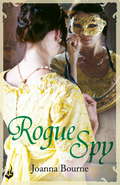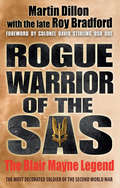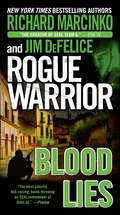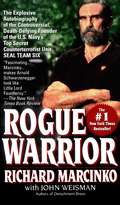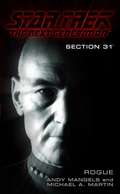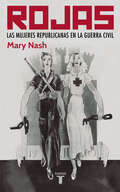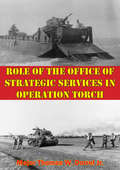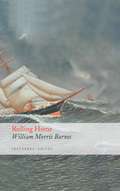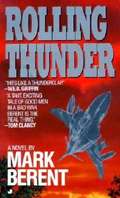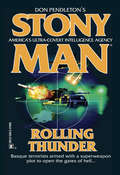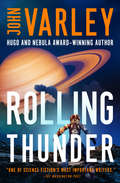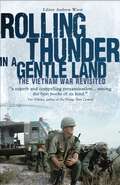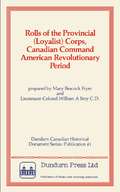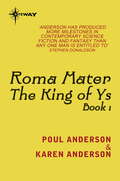- Table View
- List View
Rogue Officer (Fancy Jack Crossman #7)
by Garry KilworthLieutenant Jack Crossman finds himself plagued by one Captain Deighnton, and the roots of Deighnton's animosity appear to run deep. When Jack is abducted and accused of desertion, he has to fight to clear his name only to find Deighnton waiting for yet another, perhaps final, duel . . .
Rogue Saucer (Star Trek: The Next Generation #39)
by John VornholtThe crew members of U.S.S. Enterprise™ face deadly threats when the ship's new experimental saucer is hijacked by dangerous forces.While its own saucer section receives needed repairs, the U.S.S. Enterprise™ tests a new experimental saucer. In theory, the new saucer can survive a planetary crash landing, but will it come through intact under genuine test conditions? Riker, Data, Worf, and La Forge risk their lives to find out, and so does Admiral Nechayev of Starfleet. But a dangerous test turns even more deadly when hostile forces seize control of the saucer—and turn it against the Enterprise.
Rogue Sequence: A Novel (Ander Rade #1)
by Zac ToppingIt's 2091 and independent contract companies around the world are producing genetically modified soldiers…to be sold to the highest bidders.Ander Rade is a super-soldier, a genetically engineered living weapon, and has been dutifully following orders since he gave himself to Scythe Industries’ Gene-Mod Program several years ago. But when a mission goes sideways, he’s captured, imprisoned, and forced into brutally violent fighting pits for the better part of the next decade…until agents from the Genetic Compliance Department of the United American Provinces appear in the visitors room.Things have changed since Rade was captured. Shortly after his incarceration, the World Unity Council banned human genetic engineering and deemed all modified individuals a threat to society. Overnight, an entire subculture of people became outlaws simply for existing. But instead of leaving Rade locked behind bars, the GCD agents have come with an offer: Freedom in exchange for his help tracking down one of his former teammates from that ill-fated mission all those years ago.It's an offer Rade can't refuse, but he soon realizes the situation is far more volatile than anyone had anticipated, and must take matters into his own hands as he tries to figure out whose side he’s really on, and why?At the Publisher's request, this title is being sold without Digital Rights Management Software (DRM) applied.
Rogue Soldiers: The Disaster of the Texas Mier Expedition
by Ken LizzioAmong the greatest of tragedies of the American frontier—the Donner Party, the Alamo, Wounded Knee—a little known but no less tragic event was the Texas Mier Expedition. Originally part of a 1,200-man invasion to retaliate against Mexican incursions on Texas soil in 1842, the Expedition unfolded when several hundred fighters stubbornly defied President Sam Houston&’s orders to disband and return home at once. Fiercely independent and recently reorganized under new leadership, this motley mix of Texas volunteers and militia turned south and proceeded to invade Mexico, determined to avenge past humiliations at the hands of Mexican dictator Antonio López de Santa Anna.Once in Mexico they engaged the enemy in a dramatic day-long battle when they were suddenly tricked into surrendering and marched 1,300 miles to Perote prison. It was a march of attrition during which many Texans were executed or died from exposure, disease, or starvation. Once in Perote, they were forced to sleep on stone floors in chains and put to hard labor. Of the original three hundred and eight members of the rogue expedition who survived, only half left the prison alive. After two years in captivity, the prisoners were finally released only to be ignored and forgotten by their own countrymen upon their return home.Drawing from over a dozen first-hand accounts, author Ken Lizzie extracts this exciting narrative recounting the pathos of these fighting men—from the blood-soaked Battlefields of Mier and the subsequent surrender to their harrowing 1,300-mile forced march to Perote Prison.
Rogue Spy: Spymaster 5 (Spymaster)
by Joanna BourneJoanna Bourne returns to the French Revolution, pairing espionage and burning romance to create an unforgettable love story. For fans of Stephanie Laurens, Elizabeth Hoyt and Poldark, this is a must-read.For years he's lived a lie. Now it's time to tell the truth - even if it costs him the woman he loved.Ten years ago Thomas Paxton was a boy sent by revolutionary France to infiltrate the British Intelligence Service. Now his sense of honour brings him back to London, alone and unarmed, to confess. But instead of facing the gallows, he's given one last assignment to prove his loyalty.Lovely, lying, former French spy Camille Leyland is dragged from rural obscurity by threats and blackmail to rescue and innocent victim from a ruthless French fanatic. But she finds an old colleague already on the case: Pax. Old friendship turns to new love and, as dark secrets reappear, Pax is left with a choice - go rogue from the Service or lose Camille for ever...For more spellbinding Spymasters romance, look for the other titles by Joanna Bourne: The Forbidden Rose, The Spymaster's Lady, My Lord and Spymaster, and The Black Hawk.
Rogue Warrior of the SAS: The Blair Mayne Legend
by Martin Dillon Roy BradfordMore than half a century after his death, Lt Col. Robert Blair Mayne is still regarded as one of the greatest soldiers in the history of military special operations. He was the most decorated British soldier of the Second World War, receiving four DSOs, the Croix de Guerre and the Légion d'honneur, and he pioneered tactics used today by the SAS and other special operations units worldwide. Rogue Warrior of the SAS tells the remarkable life story of 'Colonel Paddy', whose exceptional physical strength and uniquely swift reflexes made him a fearsome opponent. But his unorthodox rules of war and his resentment of authority would deny him the ultimate accolade of the Victoria Cross. Drawing on personal letters and family papers, declassified SAS files and records, together with the Official SAS Diary compiled in wartime and eyewitness accounts from many who served with him, the picture emerges of a soldier who, although a flawed hero, was unquestionably one of the most distinctive combatants of the campaigns in the Western Desert and Europe.
Rogue Warrior: Blood Lies (Rogue Warrior)
by Richard Marcinko Jim DeFeliceWhen the daughter of a retired Navy SEAL is kidnapped and held for ransom in Mexico, Rogue Warrior Richard Marcinko and his band of Red Cell International warriors head south of the border to rescue her. Along the way, they encounter drug dealers and human traffickers, break into a cartel kingpin's mansion, and do battle with a hundred of the meanest banditos since Pancho Villa. And just for good measure, Marcinko uncovers a secret Hezbollah camp funded by the Iranian government and sheltered by the drug lords.But the founder of SEAL Team 6 finds his toughest opponent may actually be the woman he's come to rescue. And then there's the question of who really sent Dick to find her.…Rogue Warrior: Blood Lies is a stunning new installment from writing team Richard Marcinko and Jim DeFelice.At the Publisher's request, this title is being sold without Digital Rights Management Software (DRM) applied.
Rogue Warrior: Dictator's Ransom (Rogue Warrior)
by Richard Marcinko Jim DeFeliceIs Kim Jong-il really a fanatical fan of Dick Marcinko, the Rogue Warrior? Has the terrifying tyrant actually read every one of Marcinko's many New York Times bestsellers?One thing is certain: the Rogue Warrior wants nothing to do with the brutal despot. When, in Dictator's Ransom, "the loathsome dwarf"--as George W. Bush derided him--invites Marcinko to the Hermit Kingdom, the Rogue Warrior instantly declines...prompting the CIA to RSVP on his behalf. Marcinko is to track down four covert nuclear warheads secreted in the Supreme Leader's palace.More than just a thriller, Dictator's Ransom is a novel of electrifying energy and wicked wit.At the Publisher's request, this title is being sold without Digital Rights Management Software (DRM) applied.
Rogue Warrior: Red Cell (Rogue Warrior #16)
by Richard MarcinkoA brilliant virtuoso of violence, Richard Marcinko rose through Navy ranks to create and command one of this country's most elite and classified counterterrorist units, SEAL TEAM SIX. Now this thirty-year veteran recounts the secret missions and Special Warfare madness of his worldwide military career—and the riveting truth about the top-secret Navy SEALs.Marcinko was almost inhumanly tough, and proved it on hair-raising missions across Vietnam and a war-torn world: blowing up supply junks, charging through minefields, jumping at 19,000 feet with a chute that wouldn't open, fighting hand-to-hand in a hellhole jungle. For the Pentagon, he organized the Navy's first counterterrorist unit: the legendary SEAL TEAM SIX, which went on classified missions from Central America to the Middle East, the North Sea, Africa and beyond. Then Marcinko was tapped to create Red Cell, a dirty-dozen team of the military's most accomplished and decorated counterterrorists. Their unbelievable job was to test the defenses of the Navy's most secure facilities and installations. The result was predictable: all hell broke loose. Here is the hero who saw beyond the blood to ultimate justice—and the decorated warrior who became such a maverick that the Navy brass wanted his head on a pole, and for a time, got it. Richard Marcinko—ROGUE WARRIOR.
Rogue Warrior: Seize the Day (Rogue Warrior)
by Richard Marcinko Jim DeFeliceFidel Castro may be on his deathbed, but he's still scheming against the U.S. in Richard Marcinko and Jim DeFelice's The Rogue WarriorWhen Marcinko's "friend," the head of the CIA, asks him to spend a little quality time in Cuba, the Rogue Warrior finds there's no way to say no. Once there, Marcinko and company discover that Fidel Castro is on his deathbed. Which wouldn't be so bad, except that he's planned a catastrophic surprise for the U.S. as his going-away present. The Rogue Warrior must find out the nature of that little surprise and thwart it before Castro kicks the bucket.At the Publisher's request, this title is being sold without Digital Rights Management Software (DRM) applied.
Rogue: Section 31 (Star Trek: The Next Generation)
by Andy Mangels Michael A. MartinNO LAW. NO CONSCIENCE. NO STOPPING THEM.They are the self-appointed protectors of the Federation. Amoral, shrouded in secrecy, answerable to no one, Section 31 is the mysterious covert operations division of Starfleet, a rogue shadow group committed to safeguarding the Federation at any cost. Six months before their ultimate battle against the Borg for the fate of Earth, Captain Jean-Luc Piccard and the crew of the USS Enterprise™ face a very different kind of crisis. A world in turmoil becomes the focal point of conspiracies and betrayal as an unexpected reunion brings with it startling revelations. Old friends become bitter enemies and one young officer reaches a crossroad when he's forced to choose between the greater good of the Federation and the ideals for which it stands.
Rojas. Las mujeres republicanas en la Guerra Civil
by Mary NashUn examen riguroso del papel de las mujeres republicanas en la Guerra Civil española. En este libro Mary Nash hace un estudio del papel y las experiencias de las mujeres republicanas en la Guerra Civil española (1936-1939), y analiza su valiosa aportación en la retaguardia así como los logros heroicos de las dirigentes políticas y de las mujeres que lucharon en el frente. Para muchas de ellas, participar activamente en esa lucha fue una experiencia liberadora después de haberse visto aisladas de la vida pública y política. A medida que iban ganando confianza en sus propias aptitudes esas mujeres empezaron a cuestionar su papel tradicional en la sociedad y las limitaciones que les habían impuesto en razón de su sexo. Al estallar la guerra, la vida de las mujeres se transformó profundamente: en medio de duras condiciones tuvieron que organizarse a gran escala para luchar contra el fascismo y, así, empuñaron las armas, construyeron barricadas, trabajaron en fábricas de municiones, en el transporte público y en las granjas, lanzaron periódicos y publicaciones antifascistas, organizaron labores de asistencia social y realizaron todo tipo de trabajos para contribuir al esfuerzo bélico. Basado en una extensa investigación de la autora, así como en sus entrevistas con mujeres activistas en la Guerra Civil española, Rojas evalúa la significativa participación de las mujeres en la lucha antifascista contra Franco e introduce al lector en la compleja realidad de la guerra y la revolución desde una perspectiva femenina.
Rojava: Una joven armenia busca encontrar a su verdadero padre en el corazón de Medio Oriente. Un ejército de mujeres le enseña que nada en la vida se consigue sin luchar
by Magda TagtachianNané Parsehyan necesita encontrar a su verdadero padre y emprenderá una travesía hasta llegar a Rojava, donde no existe la paz: es una zona que el pueblo kurdo se disputa a sangre y fuego con Siria y Turquía. La acompañará su prima Alma Parsehyan, una periodista americana. En el corazón de Medio Oriente conocerán las Unidades Femeninas de Protección, un ejército de mujeres que defienden con valentía y coraje una tierra que lo pide todo. Nané Parsehyan necesita encontrar a su verdadero padre. Para eso emprenderá una travesía hasta llegar a Rojava, donde no existe la paz: es una zona que el pueblo kurdo se disputa a sangre y fuego con el Estado Islámico, el Estado turco y el régimen sirio. En el viaje la acompañará su prima Alma Parsehyan, una periodista americana que está por publicar una novela. Además, se sumarán Hrant Torosyan y Vartan Sirekanyan, un combatiente y un violinista, ambos armenios, que darían sus vidas por ellas. En el corazón de Medio Oriente se encontrarán con las Unidades Femeninas de Protección, un ejército de mujeres que defienden con valentía y coraje una tierra que lo pide todo. Magda Tagtachian pone la exquisitez de su pluma y su sagacidad periodística para que la búsqueda de la identidad, el amor y un conflicto territorial conformen una historia actual, en una zona arrasada por la guerra. Y allí, donde pareciera imposible que irrumpa el romance y la pasión, y que una hija pueda reconstruir la relación con su padre, el camino les deparará muchas sorpresas y enseñanzas. Y quizá sea esa la gran lección de Rojava: jamás abandonar la lucha, nunca darse por vencido.
Role Of Army Special Operations Forces In Nation Building
by Major Jeffrey J. MonteAlthough the United States (US) has been involved in nation-building efforts for the past 100 years it does not have a doctrinal definition to articulate what nation building is. Another challenge for the US is the lack of a designated agency within the US Government (USG) to lead the effort. First, an interagency, agreed upon, doctrinal definition of nation building must be established. Following this, each department and agency within the USG must be examined to identify the role each plays within a nation-building operation. This examination will allow the identification of the relationships between departments of the USG and the resources available to conduct nation building.This thesis examines the role of Army Special Operation Forces (ARSOF) in nation building. In order to do so, a definition of nation building is established, key tasks of nation building are derived, and military tasks that support a nation building operation are developed. These military tasks are analyzed against the doctrinal missions and capabilities of ARSOF in order to identify how ARSOF can contribute to nation building. This thesis concludes with recommendations on the employment of ARSOF in nation-building operations.
Role Of The Office Of Strategic Services In Operation Torch
by Major Thomas W. Dorrel Jr.This thesis evaluates the role of Allied strategic and operational intelligence in conjunction with Department of State actions in French North Africa from 1940 through the invasion, Operation TORCH, November 8, 1942. The primary focus is to evaluate whether or not the OSS collected the required intelligence information as their accounts have stated. This paper also looks at the operational requirements of advance force operations to determine if the OSS was successful in accomplishing the required tasks for the operational planning and execution of Operation TORCH. The final analysis reveals that the OSS was successful in answering most of the information requirements, but only with the help of other Allied intelligence collection agencies.
Roll of Honour: Schooling & The Great War, 1914–1919
by Barry BladesThe Great War was the first 'Total War'; a war in which human and material resources were pitched into a life-and-death struggle on a colossal scale. British citizens fought on both the Battle Fronts and on the Home Front, on the killing fields of France and Flanders as well as in the industrial workshops of 'Blighty'. Men, women and children all played their part in an unprecedented mobilisation of a nation at war. Unlike much of the traditional literature on the Great War, with its understandable fascination with the terrible experiences of 'Tommy in the Trenches', Roll of Honour shifts our gaze. It focuses on how the Great War was experienced by other key participants, namely those communities involved in 'schooling' the nation's children. It emphasises the need to examine the 'myriad faces of war', rather than traditional stereotypes, if we are to gain a deeper understanding of personal agency and decision making in times of conflict and upheaval. The dramatis personae in Roll of Honour include Head Teachers and Governors charged by the Government with mobilising their 'troops'; school masters, whose enlistment, conscription or conscientious objection to military service changed lives and career paths; the 'temporary' school mistresses who sought to demonstrate their 'interchangeability' in male dominated institutions; the school alumni who thought of school whilst knee-deep in mud; and finally, of course, the school children themselves, whose 'campaigns' added vital resources to the war economy. These 'myriad faces' existed in all types of British school, from the elite Public Schools to the elementary schools designed for the country's poorest waifs and strays. This powerful account of the Great War will be of interest to general readers as well as historians of military campaigns, education and British society.
Rolling Back the Islamic State
by James Dobbins Seth G. Jones Christopher S. Chivvis Jeffrey Martini Daniel Byman Ben Connable Eric Robinson Nathan ChandlerThe Islamic State has lost substantial amounts of territory but continues to conduct and inspire attacks around the world. This report assesses the threat the Islamic State poses to the United States and examines strategies to counter the group and prevent a resurgence of the Islamic State or other Salafi-jihadist groups.
Rolling Home (Seafarers' Voices)
by William Morris BarnesBarnes was born in 1850 into a shipowning family in St Johns, Newfoundland, and first went to sea while still a schoolboy. His career seemed predestined, and by the age of 14 he was apprenticed to a Liverpool company, serving in their sailing ships working a triangular passage to St Johns, the Brazils and back to Liverpool. He tried to swallow the anchor when he married but running a grocery store was too mundane, and he soon went back to sea, transferring his skills to the now dominant steamships.Even though he was 64, on the outbreak of the First World War he promptly volunteered for service. He does not seem to have regretted it, even after being mined or torpedoed three times; the last time he was badly injured and spent three days adrift in an open boat. Despite these disasters, like many a sailor, he was probably safer at sea while in one port he fell for a rather exotic woman, only to discover she was a German spy. When he eventually retired, to New York, he got to know a couple called Hilda and Denys Wortman. Denys was a newspaper cartoonist, who was rather taken with the gruff old sea-dog and based a character he dubbed Mopy Dick on him for a series of popular cartoons. Meanwhile, Hilda encouraged Barnes to record his adventures and she eventually became the editor of the first edition of this book, imbuing the story with far more narrative flair than usually found in unliterary memoirs.
Rolling Thunder
by Mark BerentThey were America's bravest men - seasoned veterans and young daredevil pilots with dreams of glory in the air.... Court Bannister, an Air Force Captain overshadowed by his famous father, driven to prove his worth to his comrades -- and himself.... Toby Parker, the brash young first Lieutenant who gambled his innocents and the flames of war.... And Wolf Lochert, the Special Forces Major who ventured deep into the jungle to rescue a down pilot - only to discover a face of the enemy for which he was unprepared.
Rolling Thunder (Stony Man #72)
by Don PendletonSTONY MAN The clandestine operations group known as Stony Man is unbound by rules of procedure and answers only to the Oval Office. Hal Brognola's team of cyberwarriors and battlefield commandos takes the most direct approach to stem the tide of global terrorism and high crime. As the court of last resort, they handle the dirty work no other department or agency can touch. ROLLING THUNDER The Basque Liberation Movement, a militant splinter cell of Spain's notorious ETA terrorist group, has seized a state-of-the-art new supertank equipped with nuclear firing capabilities. Intent on carrying their blood message to the world, the BLM has planned a devastating show of force at a NATO conference in Barcelona. As Stony Man's cybernetics team works feverishly to track the terrorists and the stolen warheads, the commandos of Able Team and Phoenix Force hit the ground running. But a clever, resourceful enemy remains one step ahead, in a race against the odds getting worse by the minute. ...
Rolling Thunder (The Thunder and Lightning Series #3)
by John VarleyThe third book in the Thunder and Lightning Series is &“a smashing success . . . [with] action-packed, science-packed homages to Heinlein&’s best work&” (Cory Doctorow, Boing Boing). Navy lieutenant Podkayne, daughter of Ray Garcia-Strickland, is tired of her job as Martian consul in California—and Earth&’s oppressive gravity. So she&’s OK with getting called back to Mars even if it&’s because her great-grandmother is sick and being put into suspended animation. After a family reunion, Podkayne&’s next port of call is Europa, one of Jupiter&’s moons, where she can finally realize her dream of being a singer. But just when her life seems to be improving for the better, disaster strikes and Podkayne is put into her own state of suspension. Awakened ten years later, she will discover a solar system in turmoil—where the very survival of humanity is at risk . . . &“This is well-crafted science fiction written by a master.&” —SFRevu.com &“These books are fond without being nostalgic, reverent without being old-fashioned. Everything about them is utterly contemporary, but it&’s easy to believe that Heinlein would have written them (more or less!) today.&” —Cory Doctorow, Boing Boing &“Loaded with references, some subtle and others blatant, to Heinlein&’s many books. Heinlein fans will get a chuckle, or maybe even a guffaw, when encountering one of these. Readers with no Heinlein background will enjoy the story too, but on a different level.&” —National Space Society
Rolling Thunder in a Gentle Land
by Andrew WiestFrom the Introduction In the end, then, the Vietnam War was a conflict of myriad complexities. It was a colonial war and a regional war. It was a total war and a limited war. It was a civil war, an insurgency and a conventional war - and indeed it varied from one form to another at different times and in different places. It was a war in mountains, jungles or open rice paddies depending on the location of the battlefield. It was a war of high technology and no technology. It was a war of airpower and a war of footpower. It was a helicopter war and a brown-water war. It was a war won on the battlefield and lost on the homefront. One thing that the Vietnam War was not was simply an American War. It was a war of varying and mutable contexts - a chameleon of constant change. The greatest American failure in the conflict was a failure to understand context. For far too many important American planners the Vietnam War had but one context - the black and white context of the Cold War; a context that begged an inexorable singular military logic and solution. A military solution that was so overly simple that it proved to be no solution at all. ���� The present study takes as its main goal to place the Vietnam War into its proper contexts. Though Rolling Thunder in a Gentle Land cannot pretend to answer all of the nagging questions that still surround the conflict, it can at least begin to pose new questions that have too often been left unasked or ignored. Through the work of a unique collection of historians, journalists, and war participants Rolling Thunder in a Gentle Land also seeks to spark historical debate and research by searching for new contextual answers to questions that many historians had thought long since answered - sometimes calling for a needed revision of the historical orthodoxy of the conflict. Thus the present study proposes to take fresh looks at several of the most important aspects of the Vietnam War and hopes to demonstrate that the field remains one of the most vibrant and important fields available to future historical inquiry of all types by scholars and laymen alike who seek an opportunity to help define a war of unending complexity.CHAPTER HEADS An American war? The French experience. The North Vietnamese experience. The Ho Chi Minh Trail. The war outside Vietnam: Cambodia and Laos. The South Vietnamese experience. The civilian experience. Vietnam ANZACs. US doctrinal critique. The US experience. The river war. The air war. Vietnam tactics. Vietnam in the media. The legacy of war.
Rolling Thunder: A Century of Tank Warfare
by Philip KaplanThe tank is such a characteristic feature of modern warfare that its difficult to imagine a time when its presence wasn't felt on the battlefield in some form or another. Rolling Thunder, from eminent historian and author Philip Kaplan, traces the history of the vehicle from its developmental early days on the battlefields of the Great War, to modern-day uses and innovations in response to the growing demands of twenty-first century warfare.Featured in this volume are images of some of the most highly regarded and imposing types, such as the Chrysler-built Grant, the Skoda-built Hungarian Turan and the M-26 Pershing tank, employed so extensively during the Korean War. Tanks employed during the battles of Barbarossa, El Alamein, Kursk and Ardennes all feature, their histories depicted in words and images.From the battlefields of the Great War to modern-day theaters such as Iraq and Afghanistan, the history of this impressive war machine is tracked in detail.
Rolls of the Provincial (Loyalist) Corps, Canadian Command American Revolutionary Period
by Mary Beacock Fryer William A. SmyThese published rolls are intended to provide a fairly comprehensive list of the loyal colonials who joined the Provincial Corps of the British Army, 1775-1784, that were part of the Northern, or Canadian, command during the American Revolution. The name "Provincial corps of the British Army" applied to regiments established for loyal residents of Britain’s colonies. To conduct the war against the rebels in the Thirteen colonies, the British government organized military departments at key points which the army could control. The central department was the occupied zone around New York City; the Southern was Florida; the Eastern (or Northeastern) was Nova Scotia, which included New Brunswick; the Northern was the old Province of Canada, now Ontario and Quebec.
Roma Mater: King of Ys Book 1 (KING OF YS)
by Poul Anderson Karen AndersonBefore there was an England, there was Roma Mater . . .Before King Arthur, there was the King of Ys . . .In the wild and eldritch time between the fall of Rome and the rise of our own age, the kingdom of Ys was ruled by the magic of The Nine and the might of the king, their husband. How the Nine conspired with their gods to bring him to them, though he belonged to Mithras and to Rome, is only the beginning of an enchanted saga that weaves together Celtic myth with distant memories of Roman Britain - and adds a magic of its own.
